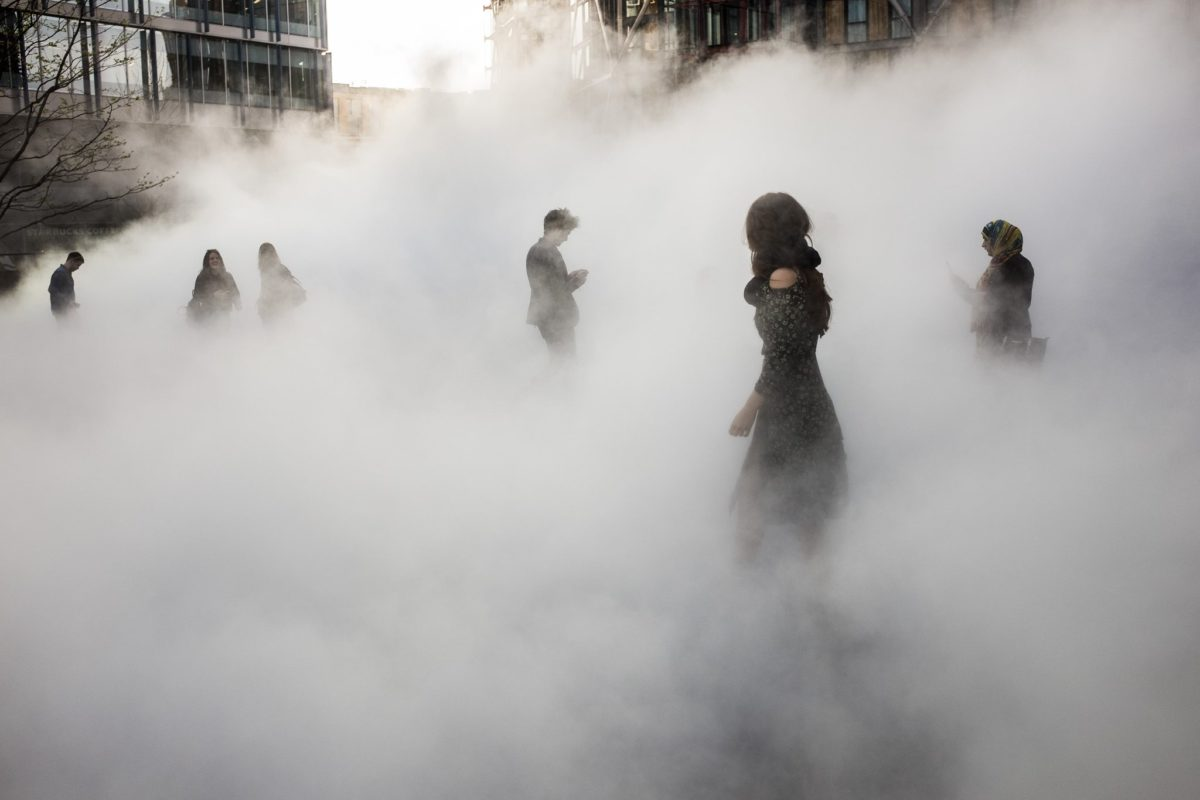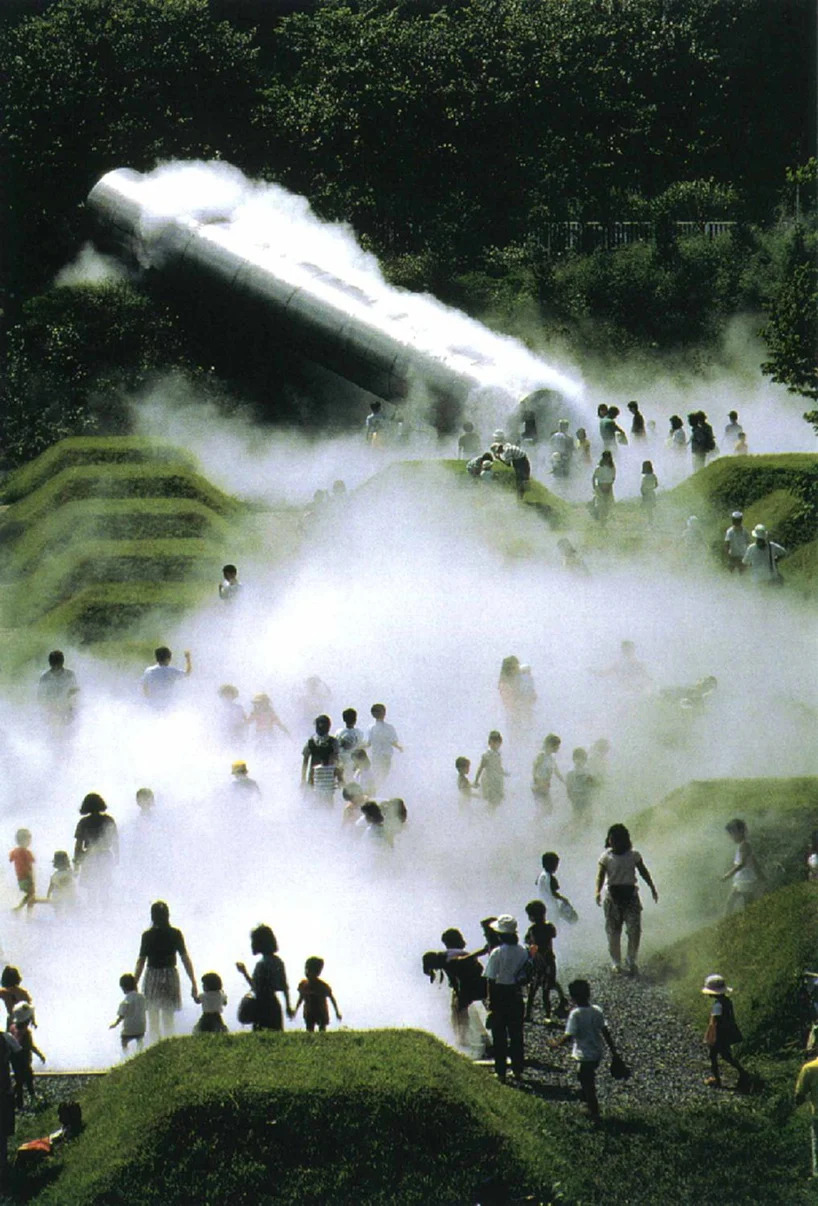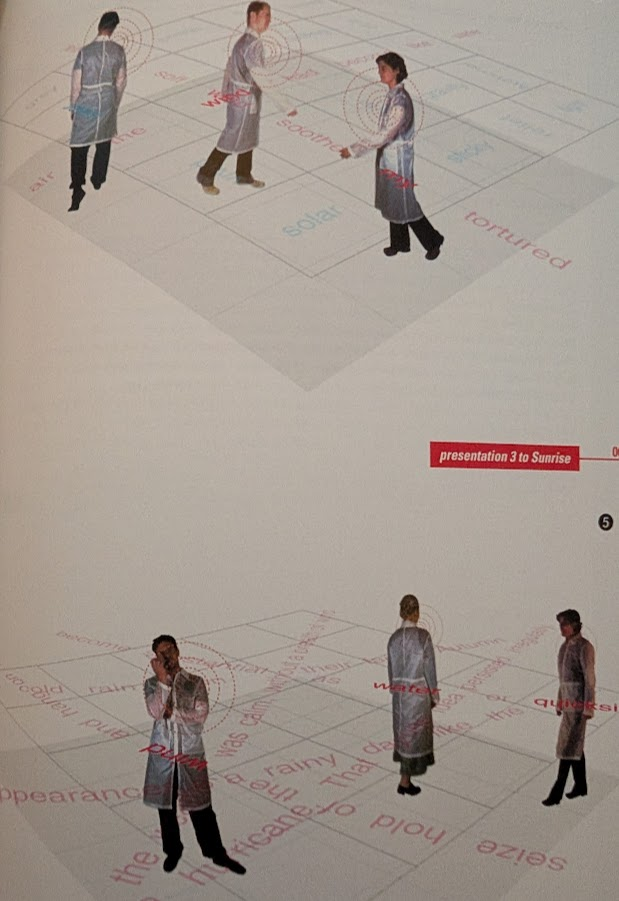created 2025-06-13, & modified, =this.modified
tags:y2025technologylovearchitecture
rel: Clouds of Architecture, Blur & Babble Blur History of Dating, Calling
Why I’m reading
Details on the Blur project, and the abandoned Babble component.
One thing I wonder is this. So this device (Lovegety) had a brief surge in JP and was tied to a website forum (traces visible on wayback, tangential reference to the red thread of fate myth). The device would ping if another user in vicinity had a similar interest like 2 party, 2 karaoke, 2love etc (I have a collection of these because it is so ridiculous and rareish now feels like passenger pigeon in 1998). The idea was proximal collection. I encountered this first some years ago by way of a group that worked on nyc high line.
I just wanted you to check out this Lovegety artifact. Even now it seems somewhat etched from the record as proto-web.
It is ridiculous and gameable (the few extant YT videos are kind of odd viewing it in practice)
But I was curious about, and maybe this exists? But why is there not such a device or app, where say you have a proximity based encounter with another human being and that “red string” pulls up on you. Maybe something is possible. Why can’t they both activate their conceivable Lovegety reloaded and if both parties do so, they are given a passive link indicating interest.
Clearly, rife with exploit (technology itself is invasive, and people can’t play nice) and abuse but…? Do you know of such tech? Some way to ephemeral zero knowledge proof date?
4 hour delay in reporting. 5 minute proximity window. Banned on baristas.
Diller + Scofidio received a directive from the Expo explaining the need to adopt a specific construction strategy based on the pool soil conditions of the lake bed, to accommodate for future developments of the site. This called for the abandonment of any landfill-based solutions.
This begins thought on a water-based/pneumatic solution.
Rather than spilling lake water down the surface of the tipped roof, … we now propose a mist cloud emerging from the roof… The skin could be lit at night from within. Texts could be laser-projected onto the mist during the day and night. The effect of the mist would appear as an optical blur floating over the lake.
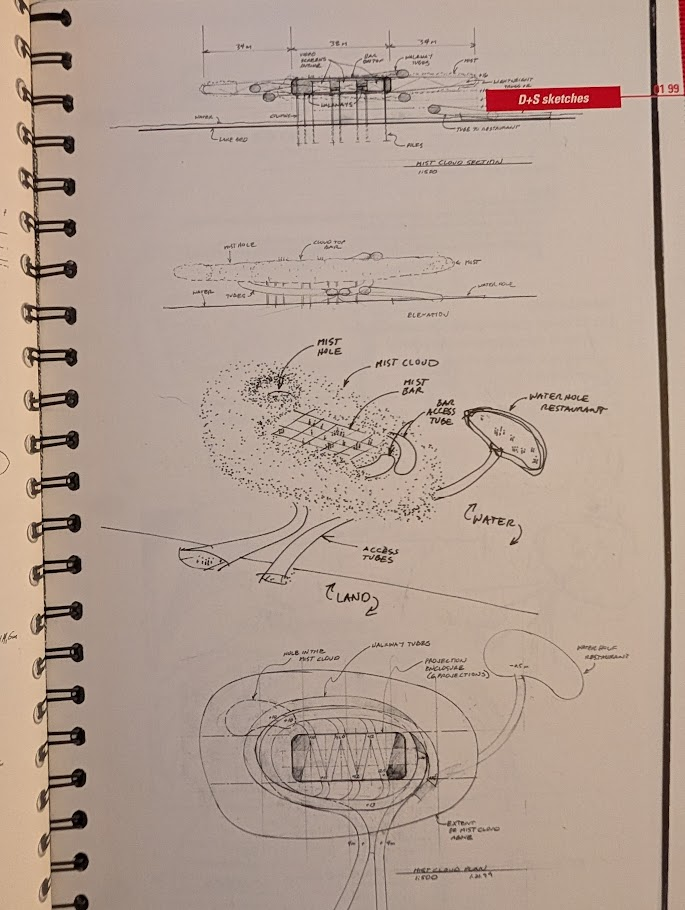
Fujiko Nakaya
Nakaya’s fog sculptures are mentioned, for she has devised a special fog nozzle, and provided an example of the first large scale use of fog.
She says “The fact that it disappears is the part I like most about fog. But it does not really disappear.”
There are extracts in the book of her priorities
- visibility – it should scatter enough light to reduce considerably the visibility of the objects behind, and at the same time make visible the dynamics of the atmosphere, otherwise invisible.
- tangibility – it should feel soft and cool to the skin
- vulnerability – it should be subject to atmospheric conditions; it should disappear not persist.
That last one is so interesting.
Her father invented the first artificial snowflake.
From 1933, Nakaya observed natural snow and created 3,000 photographic plates of snow crystals, classifying them into seven major and numerous minor types. & ”Snowflakes are letters sent from heaven”
The media event is integrated with the enveloping fog. Our objective is to weave together architecture and electronic technologies, yet exchange the properties of each for the other. Thus, architecture would dematerialize and electronic media, normally ephemeral, would become palpable in space. Both would require sophisticated technologies that would be entirely invisible, leaving only their effects.
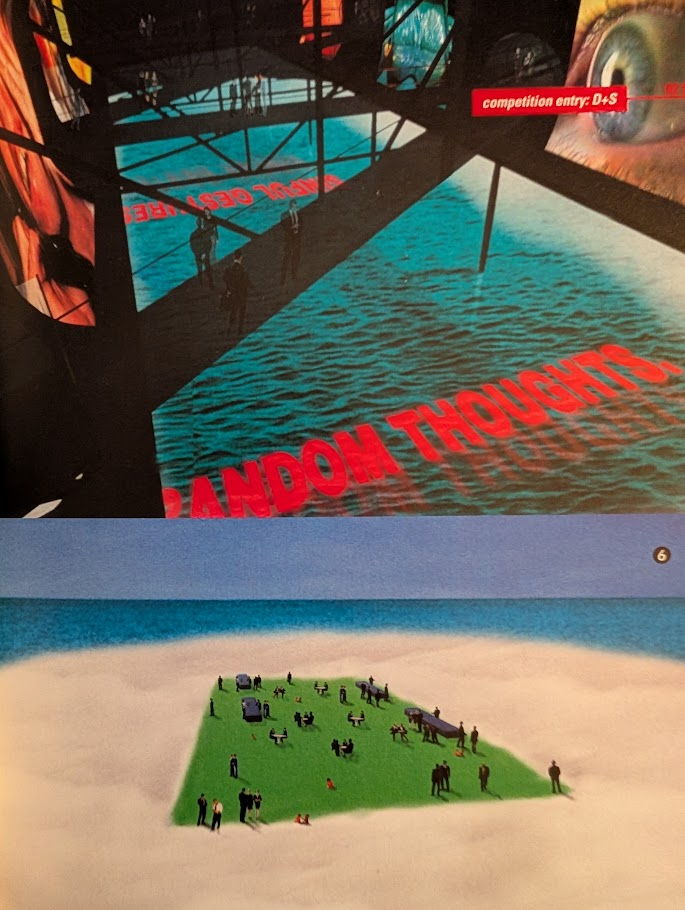
The initial tests on the water for the fog were encouraging. Despite not being able to depict a perfectly formed cumulus cloud, the artificial fog was interesting but subject to effects of mid to high level winds. A “baffle” system is considered.
We conceive of the building with a dark core in the center, like a “density” in an X-ray. IF you look at the fog mass from the shore, you will see a shadowy undefined area in the middle.
The core shell has no floor; the space is open to the water below. Ramps zigzag between the opposing walls of a shell, connecting to external circulation.
A ring aquarium is planned to surround a partially submerged (water) sushi bar.
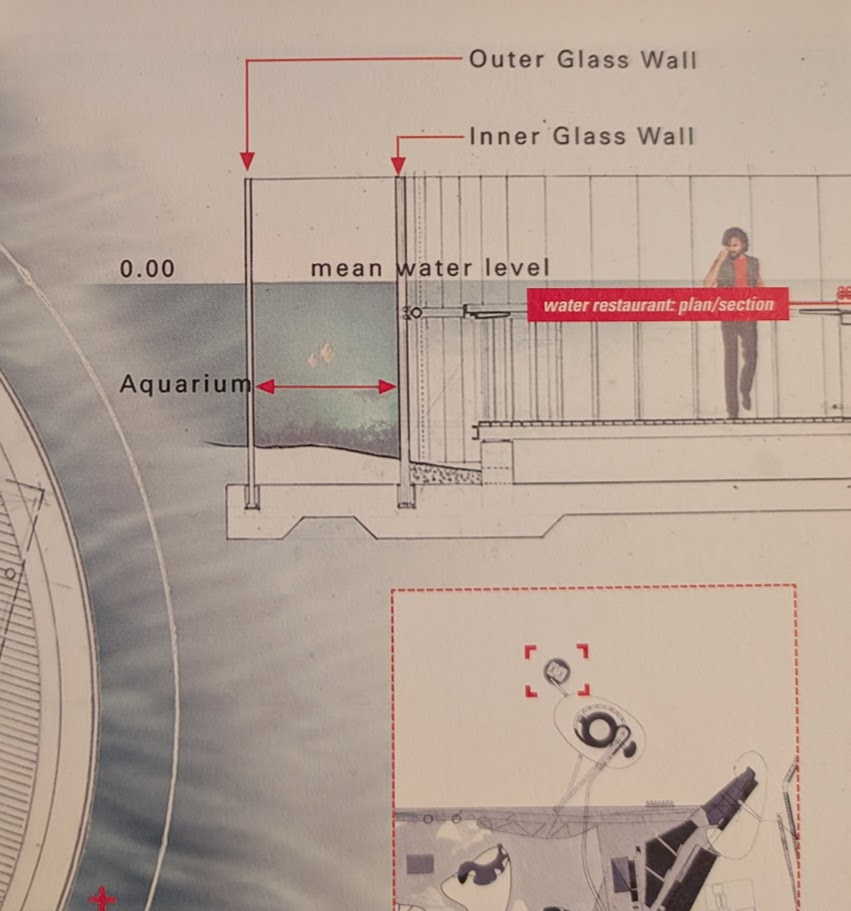 There are issues with funding and the future of the expo. The central dark core is considered to be replaced with a “luminous glass box for interactive internet events.”
There are issues with funding and the future of the expo. The central dark core is considered to be replaced with a “luminous glass box for interactive internet events.”
The glass box can become a live chat-room linked to a broadband web site. The array of LEDs can be linked directly to the internet and a single directional microphone suspended overhead can be wired to each LED. A participant would speak into the microphone and send a message out over the Web. A graphic representation of the spoke audio and/or text transmission of the spoken message generated by speech recognition software will appear on the display (a visual Echo) and stream away into fog. Within seconds a randomly selected remote participant would stream back. The dynamic texts in many languages accompanied by the murmur of automated audio translations in a variety of languages would create an electronic Tower of Babel.
A wide selection of commercially available spring waters, artesian waters, mineral waters, sparkling waters, distilled waters, rainwaters, and municipal tap waters from various international cities should be made available.
Think Tank
Thought
Rather than malice, or confusion – viewing the cloud in relation to Yūgen would’ve been cool.
As it is currently conceived the Blur building is a perfect vehicle for the most insipid subject matter: the weather. This is famously a universal, if boring, topic of conversation. Immanuel Kant used to initiate talk about the weather when he was trying to put visitors at ease, because everyone has something to say about it.
In the conversation the braincoats are considered to simulate personal weather points and cascading artificial weather conditions within the space. “the global connectedness of weather.”
“A forest of bobbing light beams, synchronized in some way to the water-dapple below”
One idea might be to have a wearable computer and endow it with the ability to pass a sound, or any kind of information, to the nearest three people. Sounds could be originally triggered by some sort of local interaction between people, and once triggered it would spread like a rumor or an infection from person to person, dying out only when every person has been reached. A sound would seems to waft over the visitors like the wind through a cloud.
Connections to fog in literature, Bleak House “Fog everywhere…” and T. S. Eliot and a “yellow fog that rubs its back upon the window frame”.
Only recently has fog become a “clean” phenomenon.
Discussion on Bokeh and Blur
Lenses are generally designed to be information gathering devices, and so the concern is resolution and contrast. Japanese photographers, however, have recently introduced an aesthetic category that entirely alters this criteria: in judging a lens, aficionados in Japan are not so much concerned with sharpness (as sharpness has become relatively easy to achieve) as they are with Bokeh - the quality of out of focus areas rendered on film.
Walter Benjamin quote from “The Work of Art in the Age of Mechanical Reproduction”: “With the close up, space expands; with slow motion, movement is extended. The enlargement of a snapshot does not simply render a more precise what was in any case visible, though unclear; it reveals entirely new structural formations of the subject. So, too, slow motion not only presents familiar qualities of movement but reveals in them entirely unknown ones, ‘which, far from looking like retarded, rapid movements, give the effect of singularly gliding, floating, supernatural motions.’ Evidently a different nature opens itself to the camera than opens to the naked eye – if only because an unconsciously penetrated space is substituted for a space consciously explored by man.”
Reading is in question in a blurry environment.
I truly believe that something radical and extraordinary could happen by pushing musical construction to the atomic level, creating ever-changing textures that mutate like the fog, but contain infinitely specific information – worth exploring – at each node or sound source. I wonder if the same thing might not be done with image – i.e., to have thousand or millions of tiny image sources, like filling the air and surfaces with pixel dust, where each pixel is in itself a compelling image or partial story – not an image/story projected onto the mist, but actually made living, mist-sized particles. And what if these sound and image mists were made from deconstructed material taken both from weather conditions and also from information “captured” from our visitors – as if these visitors had literally been decomposed on stepping off land, and twisted, floated, combined, transformed, by the time they entered the fog.
Thoughts
Consensus
The cloud is a polling device. Visitors are asked question and instructions are delivered via their raincoats as they wander through the cloud. The coat will register responses and record patterns of movement and attentiveness. A narrator/interlocutor will comment on the normalcy and abnormality of one’s responses in relation to preferred responses in the growing database. The visitor’s movement, hesitation, and degree of curiosity are recorded and added to the data collected. The narrator will change tone, becoming ultimately supplicatory, commanding and goading. At the log-out, the system will announce the most average citizen and the most pathological.
Babble, the acoustic equivalent of Blur
At the entry ramp on shore, every visitor to Blur logs in and receives a raincoat with embedded technologies. This outer skin electronically extends the body’s natural system of navigation.
Each participant becomes an acoustic interface to an audio database, and the often passive act of listening is transformed into an act of willful discovery.
The audio database will change dynamically as visitors leave acoustic traces behind. Fragments of conversations will be recorded through the raincoats, only to be discovered later as new grooves by other visitors.
Social Sifter
A proposal is made Social Sifter (a spatial profiler that sorts the visitors into subgroups like optimist/pessimist and splits them apart, ultimately finding like-minded people.) This approach is changed in a version two where:
Social Sifter #2 could be considered an extrasensory extension of the body’s natural ability to make sense of interest or disinterest in others. It is loosely modeled on the Japanese Lovegety. If our Blur system can learn about everyone within it, it can compute and compare relevant information about each person, and it can produce a response.
In our day-to-day world, we cannot escape vision as the dominant social sifter. We can visually discern differences in gender, age, race, and even social class and respond accordingly. The physical aspects of blur make such discernment difficult, as each individual in the system is anonymous. Everyone wears the same braincoat, thus male and female bodies are indistinguishable. The fog blurs faces, thus age and physical appearances are indistinguishable. What if technology could enhance our sense of discernment beyond vision.
Everyone answers a questionnaire of 20 well crafted socio-psychological questions while on line to enter Blur.
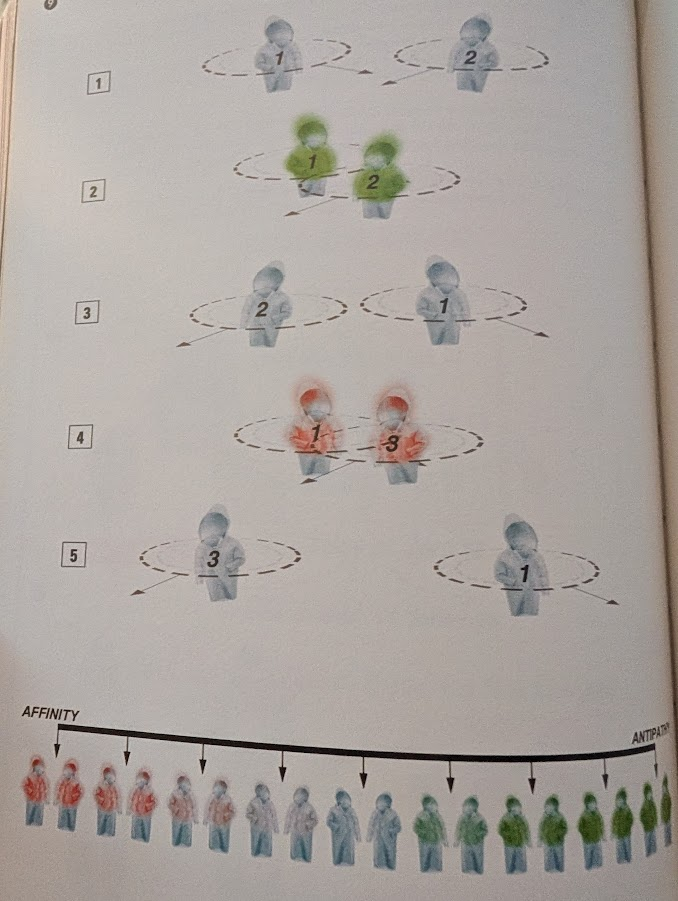
The supersensitive skin of the braincoat detects affinity or antipathy and displays it publicly on its surface for everyone to see. The coat broadcasts involuntary response, like blushing from embarrassment. The objective is not to force confrontation between visitors. On the contrary, visitors can avoid eye contact and pass one another, or have a random encounter. If the coat turns red, two people could stop and talk and attract a third person glowing red and then a forth. This could produce a red swarm. At the log-out, an individual’s cumulative readings are processed and he/she is assessed in relation to consensus or fringe.
Ideas for input of QnA
- a system of LED gates
- a sequence of turnstiles where questions would appear as visitors progress towards Blur
- visitors answer by choosing left or right gate, magnetic reader records choice.
- or, input device PDA
- or, mobile phone
- or, braincoat as input device – embedded speaker with heat sensitive switches on arms of coat.
Sinner or Saint
Beauty or Beast
Puccini or Prince
Most or Least
Saunter or Mince
Fight or Faint
One Love or Two
Old World or New
Back Door, Front Door, Do Not Enter
Left, Right or Center
Separate, Overlap
Satin or Burlap
Braincoats
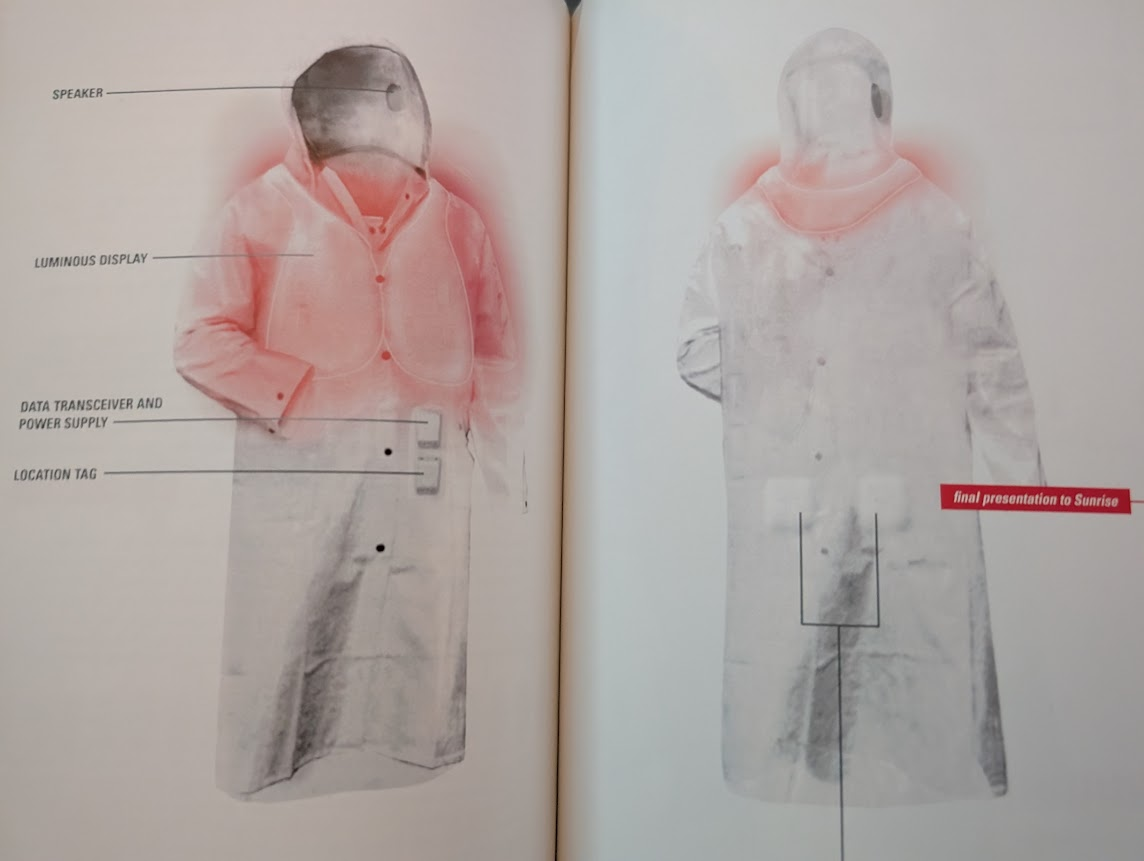 Knee length and has a hood. Capacity to display three different types of responses. Visual response, as visitors pass one another on platform their coats compare character profiles and change color indicating their degree of affinity (involuntary blush, rot werden in German). The color shifts from red to affinity, to blue-green for antipathy.
Knee length and has a hood. Capacity to display three different types of responses. Visual response, as visitors pass one another on platform their coats compare character profiles and change color indicating their degree of affinity (involuntary blush, rot werden in German). The color shifts from red to affinity, to blue-green for antipathy.
The coat has acoustic response. An acoustic pulse, like solar pinging would sound from a speaker embedded in each coat. Lin sonar, as matches approach one another the sonar would accelerate.
There’s a tactile response too. When two perfectly matched participants find each other in the fog, the motors send vibration, mimicking the tingle of excitement that comes with physical attraction.
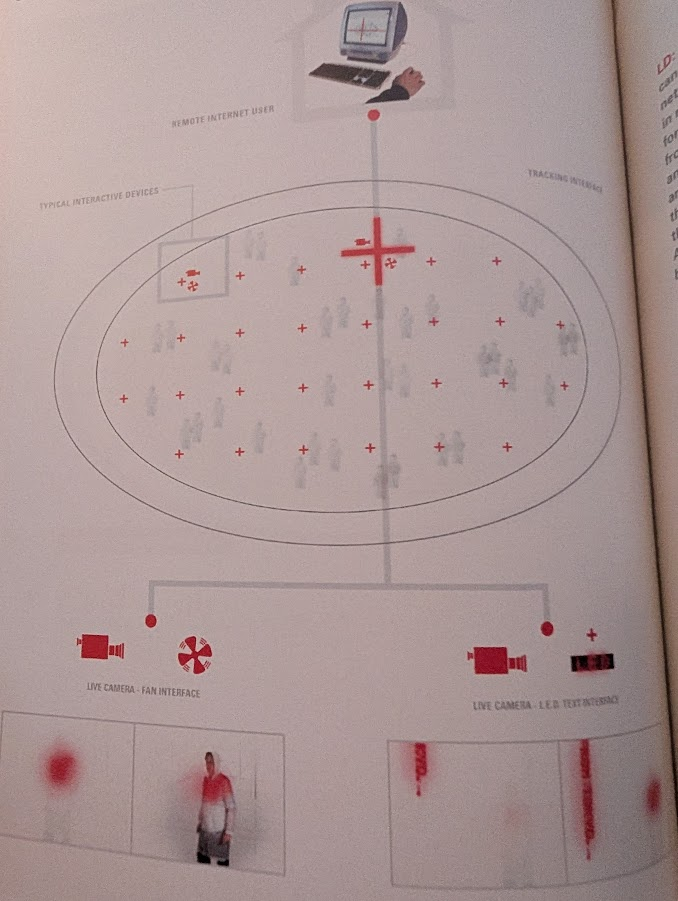 There is a web project where visitors can visit a web-based version of the questionnaire. This would allow web viewers to be positioned within the matrix of interaction on the platform. They can move their mouse cursor around the platform, which indicates the degree of affinity. If a person of interest is detected they can activate the nearest fan/webcam to catch a glimpse of the person. A small gust of wind momentarily clears the phone around him or her, and it will be felt by the visitor as a phantom presence.
There is a web project where visitors can visit a web-based version of the questionnaire. This would allow web viewers to be positioned within the matrix of interaction on the platform. They can move their mouse cursor around the platform, which indicates the degree of affinity. If a person of interest is detected they can activate the nearest fan/webcam to catch a glimpse of the person. A small gust of wind momentarily clears the phone around him or her, and it will be felt by the visitor as a phantom presence.
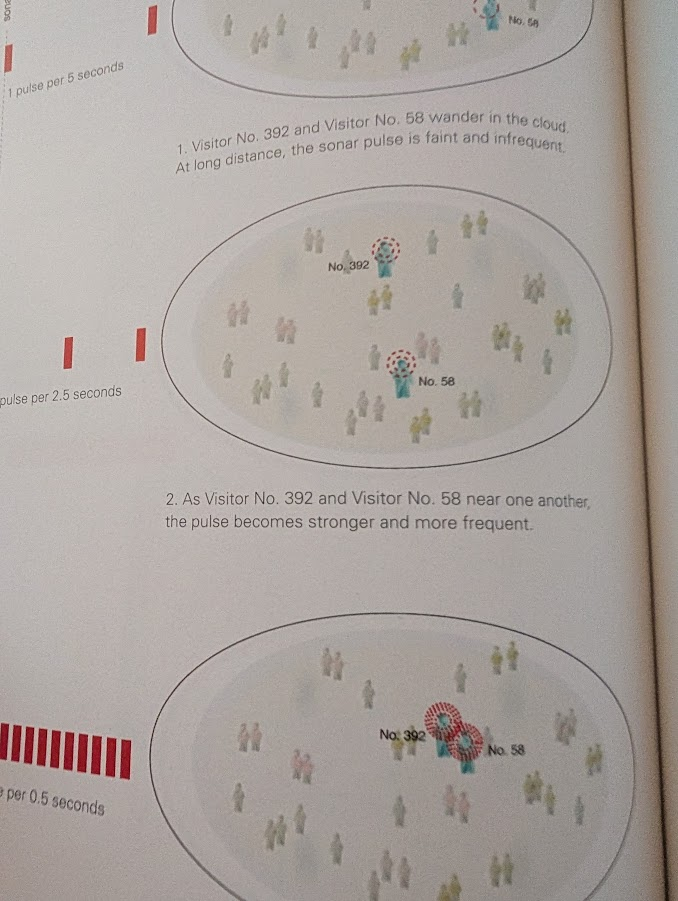
Statistical Match: Proposal: In order to match the profiles, some statistical calculations need to be performed. The exact algorithms are not known at this point. Risks: it is likely that some algorithm may be found. However, this may require a lot of computing power. This implies that some communication has to take place constantly (in real time) between a central computer and each braincoat. The risk is that we will ne be able to ensure this real-time communication.
Algorithmic complexity should be reduced so that they can be calculated by the processor locally to each braincoat. This may lead to additional costs or reduced quality of the matching process.
Thought
Some of the feeling of the chance encounters in Journey is present here.
Meet with ECA Human Safety Division of the Building Department.
Is the blur building a building? In other words, does the building code appl or not?
The Wonder Cloud
Unnecessary, serving no purpose, but wonderfully beautiful: the Yverdon cloud with its first enchanted visitors.
